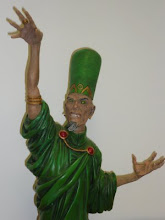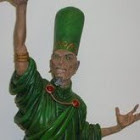
This volume contains a selection of M.C.Escher's graphic work with an introduction and commentary on each piece by Escher. In his introduction Escher notes that for a long period he was concerned with exploring and mastering the craft of creating prints from wood cuts. The images were a means of expressing and exposing the craft, later this charged so that the craft became the means by which the idea could be expressed.
The first set of images in this book are more restrained and more realistic than his later work. There is a very beautiful landscape, "Castrovalva", which is full of detail and texture. It is very much a picture of a actual place, a response to a location and an attempt to capture that reaction in a clear and vivid fashion. The sharp perspectives, the variety of tones and the division of the space in image speak to the depth of technical mastery he had achieved. There is a warm and luminous portrait of his father which is an extraordinary example of the subtlety that he was able to achieve.
The later images are, for the most part, much more clearly the expression of an abstract idea, the craft is the second impression that you get when you look at them. The picture "Day and Night" where a flock of white geese fly to the right into a night sky and a flock of black geese fly left into a daylight sky, with the patterned fields of the landscape in the centre rising up to become the two flocks is stunning. The whole is hard to take in as the movement in the picture seems to both be obvious and completely absurd at the same time. The sheer density of the information overshadows, initially, the wonderful balance and detail of the image which emerges more slowly.
Later work, such as the one pictured on the cover, "Band" with the two heads peeled like orange rinds yet clearly recognisable, somehow intertwined and floating in space have a more subtle balance between craft and content. The lure the viewer in more easily and draw the eye with a lighter touch. There is more room to enjoy the impossibility of the image, to take up the challenge the artist is presenting.
The images in this book are wonderful puzzles and teases that explore the limits and possibilities of the printed page. They are a true delight.


No comments:
Post a Comment